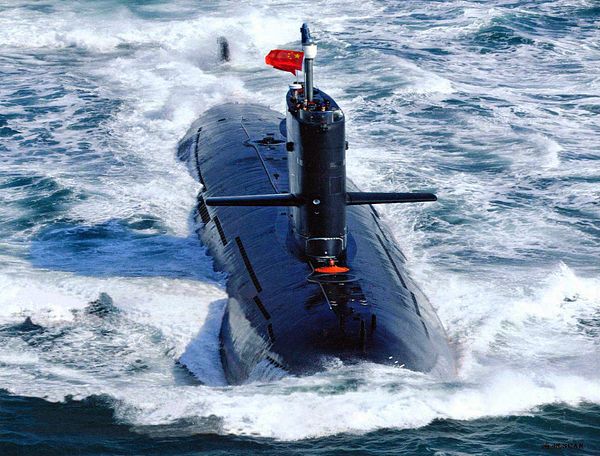Frigates escorting British aircraft carrier HMS Queen Elizabeth on Aug. 9 detected a pair of Chinese nuclear submarines attempting to shadow the Royal Navy fleet as it sailed through the South China Sea, according to the Daily Express.
A third Type 093 Shang-class submarine, the same as the other two, was detected by a British nuclear sub travelling ahead of the Queen Elizabeth battlegroup on its way to the Western Pacific, the tabloid learned.
Displacing 7,000 tons underwater and crewed by 85 officers and men, the Shang-class boats are China’s second generation of nuclear attack submarines (SSN), carrying both torpedoes and anti-ship missiles. Six have been built since 2006.
Hours after the Daily Express published its article, the Chinese Communist Party (CCP)-run Global Times challenged the possibility that the Chinese subs were detected, saying that “several Chinese military experts questioned the authenticity” of the report.
Global Times added that “the UK is [merely] showing off its presence” in the South China Sea — of which Beijing claims nearly the entirety.
The article also cited the “experts” as saying that the Shang-class subs may have “intentionally revealed themselves after having accomplished their missions, sending a warning to the UK carrier group.”
Chinese submarines still noisier than Cold War-era Soviet subs
Success
You are now signed up for our newsletter
Success
Check your email to complete sign up
Sonar operators aboard the HMS Kent and HMS Richmond detected the Type 093 submarines as the Queen Elizabeth battlegroup moved toward its temporary port at Guam. The subs were “pinged” by sonar just six hours after the group left the South China Sea.
Speaking on Aug. 8, former Rear Admiral Chris Parry who, during the Falklands War, was involved in the only combat sinking of a submarine since World War II, said: “We always worry about submarines though we worry more about Russian boats [than Chinese] because they are more advanced and quieter.”
“China is growing its sub force at speed, and we must not underestimate them, but they do not have the combat experience that US and UK submarine squadrons developed as a result of Cold War operations in the deep dark spaces of the Atlantic,” a RN source told the Daily Express.
According to data compiled by Arms Control Wonk, China’s Type 093 SSN lags far behind Russian and U.S. counterparts in terms of stealthiness.
The Chinese People’s Liberation Army Navy has deployed a number of new nuclear submarines in recent years, with the Type 095 representing a third generation of Chinese SSNs. It is unknown how many of these submarines have been laid down or launched.
According to the UK Ministry of Defence, the British Carrier Strike Group comprises 9 ships, including HMS Queen Elizabeth, 32 helicopters and jets and 3700 sailors, aviators and marines.
Britain announced that it would permanently deploy two warships in Asian waters after its Queen Elizabeth aircraft carrier and escort ships sail to Japan in September through seas where Beijing is vying for control.
British forces also participated in this month’s U.S.-led Large Scale Global Exercise 21 (LSGE21), which concluded on Aug. 27.














